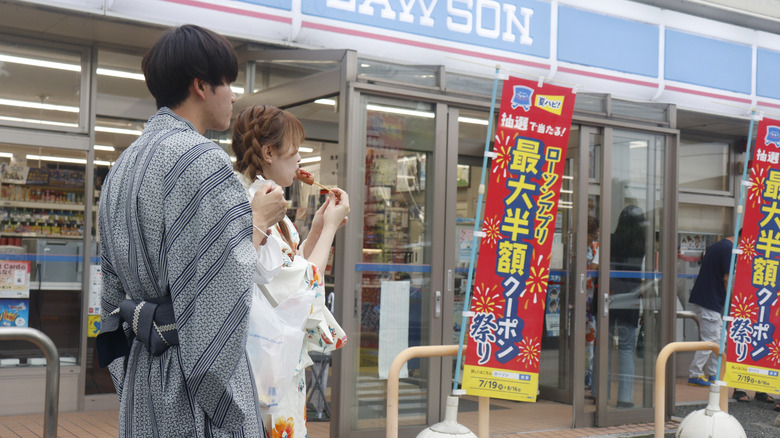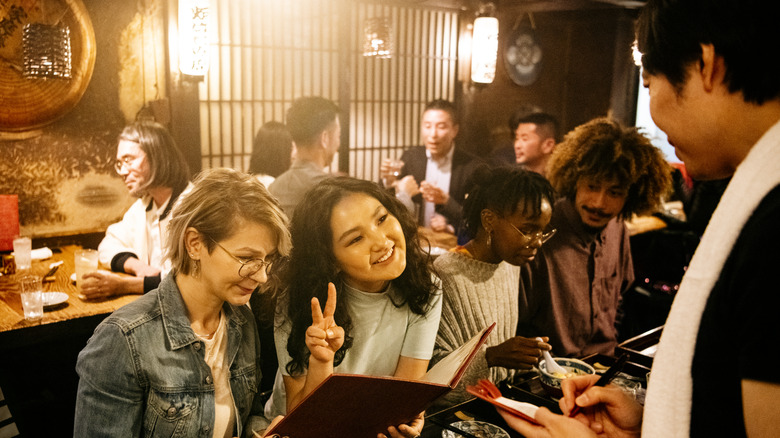Locals In Japan Will Instantly Know You're A Tourist With One Common Food Habit
One of the first discoveries a tourist makes in Japan is the abundance of street food, clean and well-stocked "konbini" (convenience stores), and fast food outlets, where an incredible selection of hot and cold beverages and bites are waiting to be devoured. Once you've made your selection and paid, there is an unspoken rule amongst the locals — do not walk and eat. Even though you'll see locals in Tokyo pressed for time as they navigate the world's busiest train station, you will rarely see someone carrying a burger or piece of fruit in hand as they hustle to their next appointment. And if you decide to snack on the go, you might have trouble disposing of your litter on the street.
Millions of people are knocking Japan off their bucket list, with the country having over 30 million visitors in 2024. Overall, the Japanese understand that not everyone will speak the language, or understand many cultural nuances that make the country unique. However, tourists should still try to be considerate when visiting Japan, including following how locals eat, take public transportation, or interact in public. After locals purchase a hand-held snack they will normally eat inside or outside the store, in a park, or bring their purchase home to avoid "meiwaku" (being a nuisance) by disrupting the atmosphere and social harmony.
Even if you may be invisible as an individual in Tokyo or Kyoto, thousands of tourists who do not follow Japan's cultural norms from throwing away trash correctly to proper train etiquette cause real strain between locals and foreigners. And since Japanese culture is high context, with indirect communication and a high degree of uncertainty avoidance baked in, locals will likely not approach a foreigner to say "Your behavior is making me feel uncomfortable" when they are breaking etiquette.
The magic word: sumimasen
The Japanese language is notoriously challenging and complex for foreigners and native Japanese alike. However, if you are looking to break the language barrier and go local, one of the must-learn (and most useful) words in Japanese is sumimasen (すみません). Sumimasen is often translated into English as "sorry," however, the word is often used for more than apologizing for mistakes; it shows you are being culturally sensitive and you have genuine respect for others around you.
Sumimasen is incredibly versatile in Japanese, and you will likely hear the word if you visit a restaurant or subway station, or as an icebreaker to get someone's attention, for example before asking a local for directions. If you visit a restaurant, use sumimasen once you are seated to call over the wait staff to take your order or to ask for the bill. Sumimasen also comes in handy when taking public transportation, especially on Japan's crowded subways. If you're stuck in the middle of a train carriage, calling out sumimasen will get people's attention that you are trying to exit at the next station and need them to step out of the way for you.
Depending on the situation, sumimasen can also be used as a way to say thank you, especially if someone has put in effort to help solve your problem. It shows you are aware and mindful of the other person's time, and show genuine appreciation for their work and for the trouble they took to help you. For example, if someone held a door for you or saw you leave an umbrella on the train, they may say "sumimasen!" to get your attention, and an appropriate response to respectfully acknowledge their help would be "sumimasen!"
Japanese dining etiquette tips
Japan's diversity in food attracts travelers from all over the world who want to try everything from Anthony Bourdain's favorite yakitori skewers to dangerous foods that could even kill you. If you are trying not to look like a tourist, here are a couple of tips to blend in and eat like a local. After cleaning their hands with a wet towel, Japanese normally begin a meal by saying "itadakimasu" (いただきます), meaning "I humbly receive." Doing so shows deep gratitude for every part of the meal, from the effort of the cooks to the elements and life forms that produced or died to be at the table with you.
If you've visited a Japanese restaurant, you'll know that meals normally come with a side of rice served in a small bowl called "ochawan" (お茶碗) and a side of soup, served in an "owan" (お椀). When eating rice or soup, Japanese normally hold their bowls in their left hand, then use chopsticks in their right to take bites from the bowl. When you are between bites, do not stick your chopsticks into the bowl, but use the chopstick rest or rest them horizontally across the top of your bowl. And for soup, move the bowl toward your lips and directly drink from it — and even slurp! Once you've finished your last morsel, saying "gochisosama deshita" (ごちそうさまでした), meaning "that was a feast," will impress the restaurant staff and shows you enjoyed the food.
And, here are a couple of cool Japanese language facts: the kanji characters for right (右) and left (左) contextually show the appropriate use for each hand. The kanji meaning "right" has a character inside it meaning mouth (口), while "left" (工) has a character meaning craft or work.


